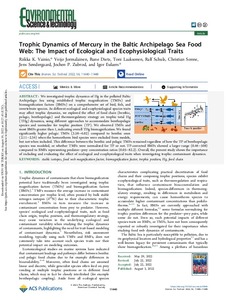Trophic Dynamics of Mercury in the Baltic Archipelago Sea Food Web: The Impact of Ecological and Ecophysiological Traits
Jormalainen Veijo; Zubrod Jochen P; Dietz Rune; Søndergaard Jens; Sonne Christian; Schulz Ralf; Eulaers Igor; Laaksonen Toni; Vainio Riikka K
Trophic Dynamics of Mercury in the Baltic Archipelago Sea Food Web: The Impact of Ecological and Ecophysiological Traits
Jormalainen Veijo
Zubrod Jochen P
Dietz Rune
Søndergaard Jens
Sonne Christian
Schulz Ralf
Eulaers Igor
Laaksonen Toni
Vainio Riikka K
AMER CHEMICAL SOC
Julkaisun pysyvä osoite on:
https://urn.fi/URN:NBN:fi-fe2022091258706
https://urn.fi/URN:NBN:fi-fe2022091258706
Tiivistelmä
We investigated trophic dynamics of Hg in the polluted Baltic Archipelago Sea using established trophic magnification (TMFs) and biomagnification factors (BMFs) on a comprehensive set of bird, fish, and invertebrate species. As different ecological and ecophysiological species traits may affect trophic dynamics, we explored the effect of food chain (benthic, pelagic, benthopelagic) and thermoregulatory strategy on trophic total Hg (THg) dynamics, using different approaches to accommodate benthopelagic species and normalize for trophic position (TP). We observed TMFs and most BMFs greater than 1, indicating overall THg biomagnification. We found significantly higher pelagic TMFs (3.58-4.02) compared to benthic ones (2.11-2.34) when the homeotherm bird species were excluded from models, but not when included. This difference between the benthic and pelagic TMFs remained regardless of how the TP of benthopelagic species was modeled, or whether TMFs were normalized for TP or not. TP-corrected BMFs showed a larger range (0.44-508) compared to BMFs representing predator-prey concentration ratios (0.05-82.2). Overall, the present study shows the importance of including and evaluating the effect of ecological and ecophysiological traits when investigating trophic contaminant dynamics.
Kokoelmat
- Rinnakkaistallenteet [19218]
